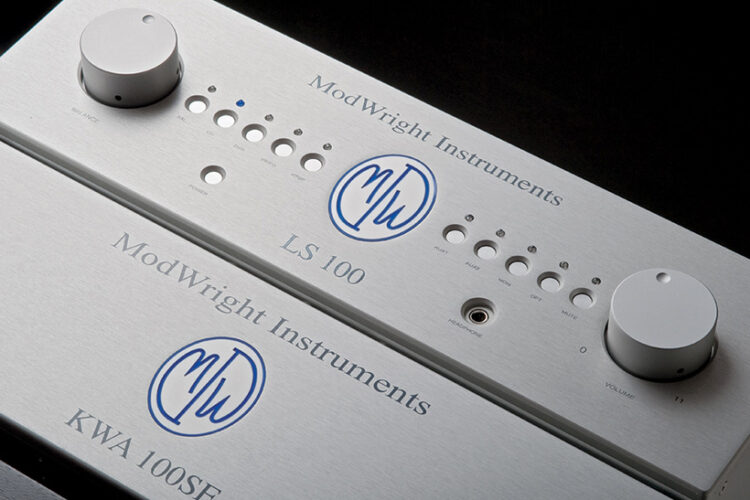Some names do pop up every once in a while, one of them is Dan Wright, owner and founder of ModWright Instruments in the USA. I came across his products at a friend’s place in Munich last year and recently again when visiting a dealer in Holland. The dealer lent me the LS 100 preamplifier and a KWA 100SE power amplifier. I have been listening for a few weeks and the blue light behind the logos and on top of the amps softly lights my room with a display of the maker’s name of this hand-built equipment.
Looking at the amplifiers I still do not know whether I find them nice looking or a bit ugly. They are a bit strong on branding with the company name and model writ large, and between these statements a large logo, backlit with a blue LED. The covers have milled slots for cooling reasons and the blue lights illuminate the front halves. On the power amplifier a switch on the back turns on some more LEDs to illuminate the whole of the top from the inside. Left and right on the front of the preamp we find balance and volume controls. A row of ten push buttons activate the four RCA inputs, XLR input, tape (with monitor) and home theatre bypass. The balance control can be switched out of the circuit and the last button is for mute. The blue LEDs above the push buttons look like laser beams, I wish red or green lights would come back into fashion. Under this row there is an on/off switch and a headphone outlet. The latter is driven from the tubes inside the box and not by any additional circuit. A simple remote control doubles most of the functions. Turning the preamp around shows all the inputs plus two RCA and one XLR output, although this XLR is wired single ended and not fully balanced. There are also 12v triggers, but strangely no trigger inputs on the power amplifier. There’s also a small, removable plate where a phono or DAC board can be installed, but these boards were not included, neither was a luxury remote, all are available at a premium. Under the hood is a tube circuit with a 5AR4/GZ34 rectifier and a pair of 6SN7 driver tubes. So a little tube rolling can be done to alter the sound to taste. The circuit is a single gain buffer, phase inverting, with a bandwidth from 20 Hz to 100 kHz. Gain is a nice choice of 12 dB while input impedance is 38 kOhm and output impedance 300 Ohm. Looking inside there are a lot of high quality components, a very large toroidal transformer and minimal wiring. Capacitors are stamped with a ModWright logo, probably not specially made but handpicked for the amplifier. It’s a well built piece of equipment.

The power amplifier has fewer buttons and controls. The main power switch is on the back, a stand-by button is hidden under the left corner of the front panel. A ground switch detaches the enclosure from earth in the unlikely case of hum. There are only single loudspeaker terminals and the inputs are RCA and XLR. What’s unusual is input transformer coupling for a floating balanced signal path, a rare sight in transistor amplifiers. The KWA 100SE has some improvements over the standard KWA 100, instead of three pairs of output devices we have five pairs of MOSFET transistors per channel, a 100% capacity increase in the power buffer section up to a generous 180.000 µF, and last but not least key signal and buffer capacitors/resistors are now MWI types and Takman carbon film resistors. The so-called single voltage gain stage delivers 100 Watts at 8 Ohm and 150 Watts into 4 Ohm per channel. The first Watts are as usual class A. Gain is 26 dB without overall feedback and bandwidth goes from 10 Hz to 100 kHz between zero and minus 1 dB. The input sensitivity is a regular 1.5 Volts. Inside the aluminium box a very large power transformer feeds the single circuit board. Wiring is kept to the minimum and the heat sinks run barely warm. Like the preamp, build quality is of a high standard. Dimensions are the same as those of the preamp, although the KWA 100SE is a bit higher because of the three large spikes that support the amp.
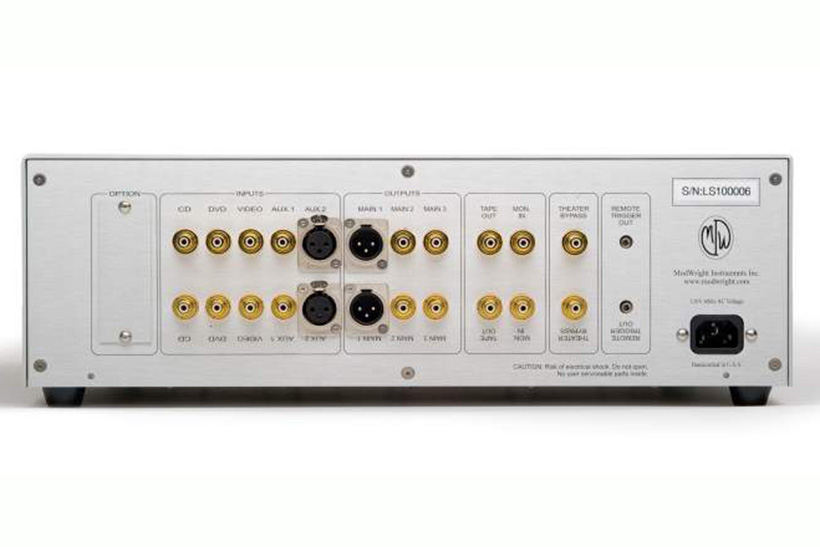
After days of casual listening and switching equipment around the ModWright amplifiers, it’s time for more serious sessions to try to pinpoint whether these amplifiers are worth the money. Sources are a NAD M50/M52 streaming combination with Esoteric D-07/G-03X digital-to-analogue conversion and a Transrotor/SME/Transfiguration record player. Since my review sample of the preamp has no phono board inside I used my own tube MC phonostage. All components are wired with Crystal Cable Connect Ultra interconnects, and the power amp is connected with a balanced Yter cable. Crystal Cable Speak Reference runs to a pair of PMC fact.12 loudspeakers. Care has been taken to clean the mains power with heavy Kemp Elektroniks filters, except for the power amp that runs direct from a dedicated audio spur. The result is a fresh sounding set-up with a lot of detail, it’s fast and energetic. I expected the ModWright amps to sound warm since the preamp relies on tubes and the power amp on MOSFET transistors, but this is not the case. On a Three Blind Mice recording of the Tsuyoshi Yamamoto Trio the piano is crystal clear, although not over the top. The amps sound fast and dynamics are good, but not the best I have heard. The bass does lack a little energy compared to my own power amplifier, which is fine because I dislike overwhelming and booming bass. Normally I roll my fact.12 speakers off in the bass with a switch on the back of the speaker, I can now set it to the neutral position for an excellent result. Percussion is clear with nice hi-hats, tender and softly brushed. The lack of distortion and the absence of even very low background noise lets every instrument shine. The same sort of piano notes come from a CD by Rachelle Ferrell singing My Funny Valentine live in Montreux. On this piece of music you hear that the tube preamp cannot fully match my costlier transistor type in the lower notes. Bass could be a bit better defined, however the ModWright is more tight than most of its counterparts and does keep control. The singer’s voice is among to the best I have heard at home, totally in balance with the band and with excellent clarity of lyrics. Not too big or too small either, with a lot power to speak out. But the dynamics show that the mid is favoured compared to the high and low frequencies.
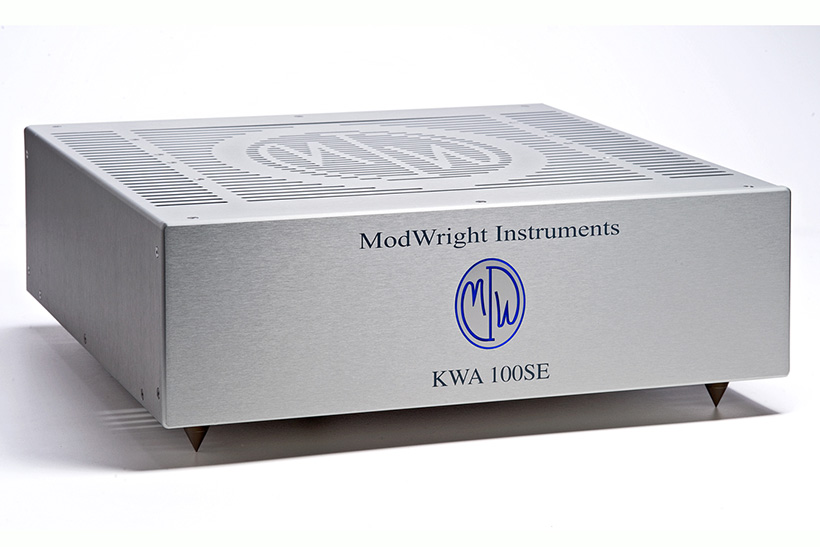
I like the duet Fever on Ray Charles Loves Company where he is joined by Natalie Cole. On lesser set-ups Ray Charles leads the song, the better the system gets, the more Natalie Cole takes over. With the two ModWrights Charles and Cole balance nicely but Miss Cole is in control. Voices are well defined and when a brass section comes in, the sound does not become brash; the fact.12s seem to love the power the KWA 100SE is able to throw at them. The Canadian singer Loreena McKennitt made a CD in 1995 named A Winter Garden; Five Songs For The Season. McKennitt plays the harp while she sings with her very pure voice, I have seen the lady play live a couple of times, they are performances you never forget. The atmosphere of the theatre is easily recreated by these amps, stereo image is well laid out in front of the listening position, not to close, but close enough to get really involved. Loreena’s voice is placed before the band, escaping from speakers that seem to disappear from the room. Maybe the mid tones are a little highlighted compared to the bass and treble, but it is a nice highlight. Stereo image is on the other hand not the widest or deepest, it’s more compact, but thanks to the excellent detail reproduction, instruments and voice do not pile up. When my laptop runs out of battery power I fetched my mains adapter from another room and I could hear just as much instrument separation as in front of the speakers. This is always a good sign for transparency. Before I change to classical music a last song is played, this time in Chinese from Luo HaiYing on the CD Supernatural Yala, which is full of percussion, large drums, strings and a nice voice. I’ve no idea what she is singing, no need too. Halfway through the song the speakers are tortured by the drums, beaten fast and increasingly loud. Again these amps do not deliver the best dynamics ever, but the speaker is kept under control and definition remains stable even at high volumes. Tiny percussion instruments come out as fast as they should do. The strength with popular music is definitely on voices, also on the detailed and delicate high frequencies, but less on raw bass notes which lack the pressure that fat bi-polar transistor amps will bring you. Nevertheless, tight bass is better than booming bass in my book.
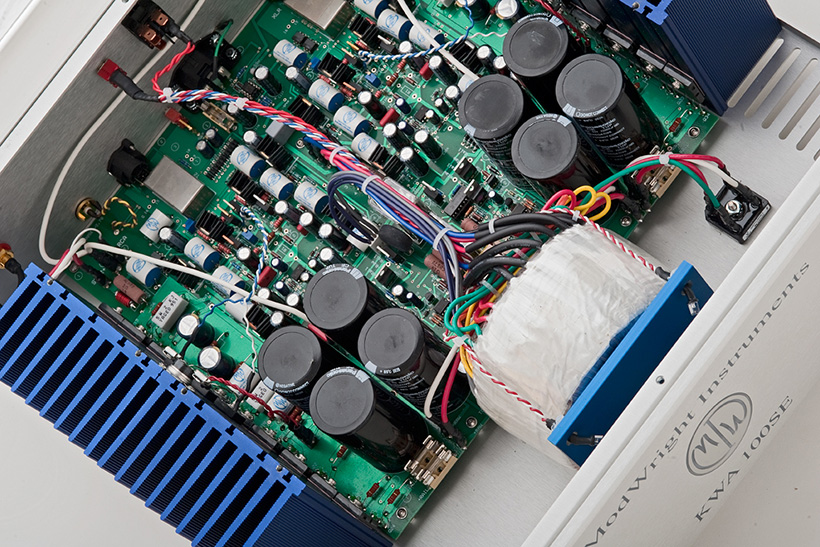
Bear in mind my preference for baroque music and it will be clear that the ModWright combo is just my cup of tea when playing some Telemann Table Music from an old Telefunken recording released in 1970. String instruments combined with two Dutch gentlemen playing the flute on a well preserved LP with only a few ticks on it. The stereo image is just like you get it in a concert hall a couple of rows from the stage; widely spread out, room for each instrument but still playing as a whole. Strings have bite, bass and cello come out nicely, the flutes are clear. No rough edges, well defined and very romantic. Music for dining lovers I would say. I can’t help myself playing the B-side where the flutes make room for oboe and trumpet. For those interested, the complete title is Die Overtüren der Tafelmusik played by Concerto Amsterdam, on this occasion conducted by Frans Brüggen. The rather naughty sleeve shows a painting of a dinner table with a half-naked lady sitting on her chair, I told you this is music for lovers. About eight years later The Broadwood Heritage by Malcolm Binns was released. Binns plays the original Shudi-Broadwood harpsichord and Broadwood fortepiano, with compositions from among others Beethoven, Chopin and Mendelssohn. In those years the L’Oiseau-Lyre record label was one of my favourites and I now remember why. How beautifully the ModWright duo reproduces the fortepiano in my room. Without any effort music flows around, almost like the instrument is right in front of me. I was already convinced of the qualities of the LS 100 and KWA 100SE on pop music, this classical works surpasses my expectations. I’ve only one criticism left, give me a bit more low end to enhance the sound of wood.
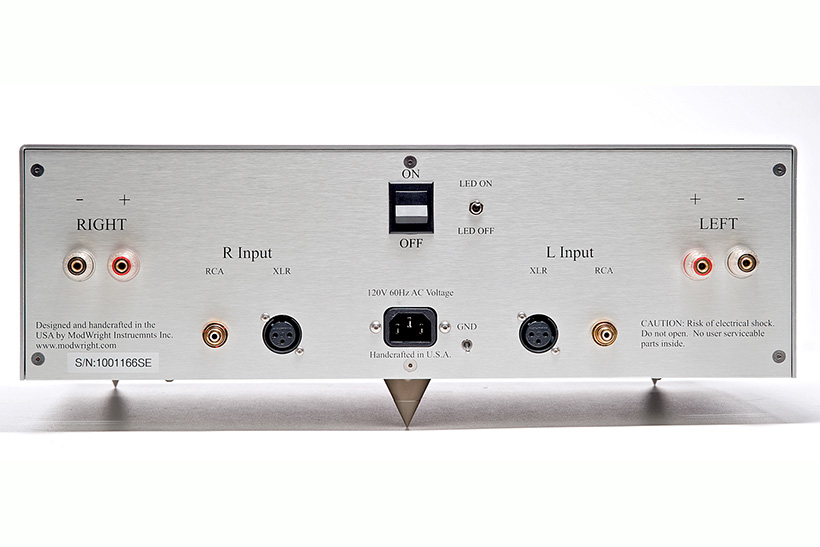
Despite the simple remote control and the blue LEDs that shine in my eyes, the ModWright combination stole my heart for one simple reason, it reproduces music the way I like it. The midrange is wide open and detailed, very pure, very fast, without any nasty grain. The top end is smooth, but not too smooth, just right. The only shortcoming is the bass which could have a bit more power. Tonally it’s on the neutral side, you would not believe the preamp uses valves. Stereo image is among the best playing vinyl and also very good with streaming, showing exactly what my sources add or subtract. It is pure, efficient and simple. The power amplifier is neutral and behaved just as well with single ended as balanced cables, probably because of the input transformers. This combination is very transparent to the sources you use and it will please those who actually listen to music, instead of playing it loud enough to massage their internal organs. ModWright’s do not come cheap, but they promise a long period of friendship. Recommended indeed.


